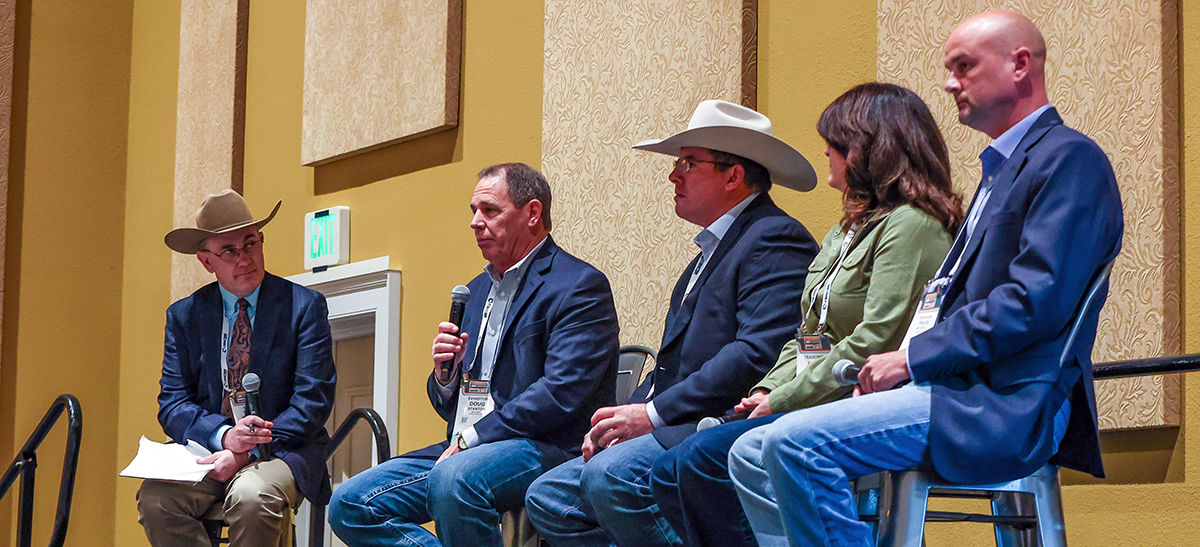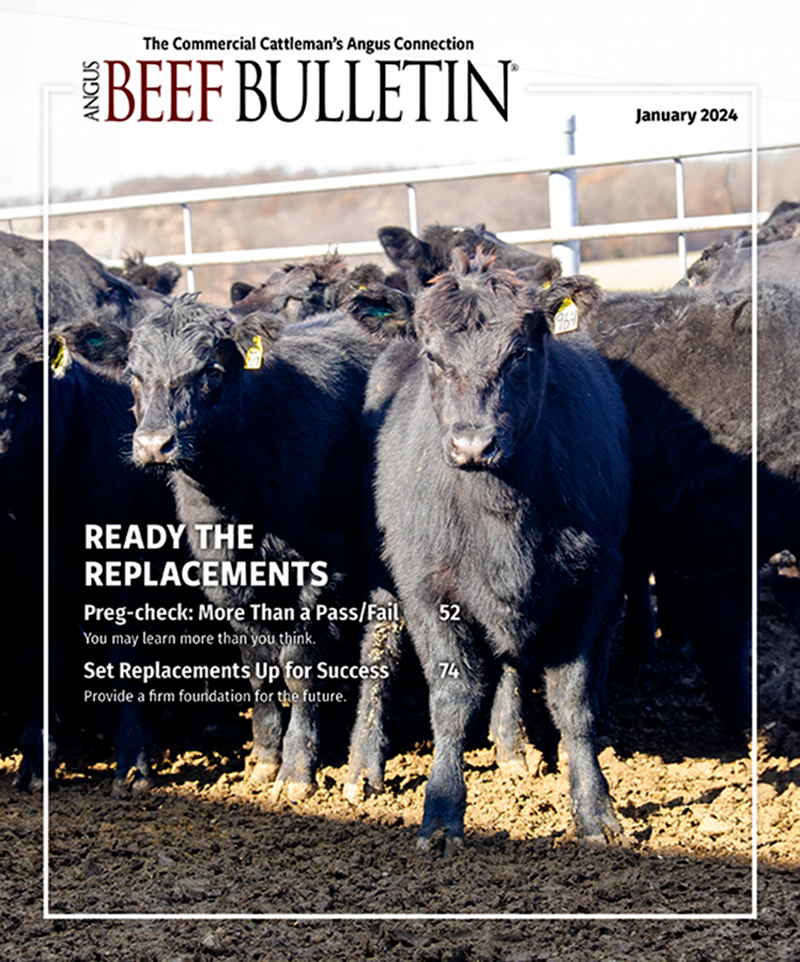
Panelists Talk Capturing Value During Angus Convention
An Angus University session on marketing cattle brings together commercial cattlemen, seedstock producers and industry representatives.
It’s easy to get stuck in the mindset of, “Well, that’s how we’ve always done it.” Fortunately, change and innovation run aplenty in the cattle business.
In November, the 2023 Angus Convention’s educational program highlighted innovations in the beef cattle industry and gave producers a chance to talk about challenges and opportunities they see in the future.
One session, the Capturing Value panel, discussed marketing strategies for commercial cattlemen while building relationships between seedstock producers and their commercial customers.
 |
Four uniquely qualified panelists — Travis Mitchell with Clemson University’s Cooperative Extension Service, South Carolina Cattlemen’s Association and Mitchell Farms; Lydia Yon, Yon Family Farms; Tracy Woods, 44 Farms; and Doug Stanton, IMI Global — encouraged producers to take advantage of value-added programs and to stay informed about industry trends and opportunities.
They represented a variety of experiences and marketing strategies, having worked with producers from across the United States — whether selling at local livestock auctions or large video sales — and of varied herd sizes.
Seeking more profit
“What I’ve noticed over my Extension career is commercial cattlemen do a great job of raising cattle,” Mitchell said. “They do a great job of taking care of calves, weaning, vaccinations, spending their money on the right genetics, but they lack sometimes in making sure that they’re marketing those cattle.”
“As a commercial cattle producer, take responsibility in marketing your cattle and reach out and use these resources that are available to you,” he told the audience.
On the panel, Stanton talked about the types of verification services IMI Global provides and what those resources can do within the current cattle market.
“We’ve seen record prices and really good prices on the calves and the yearlings compared to a year ago,” he said. “We expect that to continue for the next two to three years. We have been a little pleasantly surprised by the fact that premiums in the marketplace have been at or above the base price of what they were over the last couple of years.”
IMI Global is an agricultural and food verification and certification company. Stanton helps manage beef verification programs like Age and Source, AngusLinkSM value-added programs, NHTC (non-hormone-treated cattle) claims and others.
“Third-party verification is essential for validation of whatever trait it is,” he said, adding that higher calf prices present an opportunity to try some of these programs. “You have a little more money in your pocket, and it’s a good time to try [value-added programs], because we feel like the premiums are still going to be there in the marketplace.”
Many producers are already doing the work needed to qualify for programs, and getting paid for added value in their cattle is one way to be recognized, Woods added. “A lot of people don’t want to be at the top of the totem pole, if you will, but they want to get some recognition for the good things that they’re doing.”
Woods works as the chief genetics officer for 44 Farms, Cameron, Texas. In that role, he helps build supply chains, which focus on meeting consumers’ demands for high-quality meat.
For the process-verified programs IMI Global offers, completing an application is the first step to enrolling cattle, said Stanton. “Probably the most popular way that our customers participate in these value-added programs is through the video sales.”
Working together
From a seedstock perspective, Woods and Yon talked about how they try to help their customers find success marketing their cattle. About half of the panel session’s audience self-identified as seedstock producers.
“We definitely are data-driven, but we also try to be very tuned in to what our customers need from us and what we need to do to help facilitate them being profitable,” Yon said.
Yon Family Farms, based near Ridge Spring, S.C., hosts two sales a year, selling around 450 bulls annually. She said herd sizes in the Southeast present a challenge — trying to stay competitive even when producers are not able to sell cattle as load lots on their own.
“I’m going to be the first person to tell you I’m not an expert on G.A.P. (Global Animal Partnership Certification),” Yon said. “I’m not an expert on what it requires to be an NHTC or All-Natural. I understand the concepts. I follow the programs, but I can’t go to somebody’s farm and say, ‘You need to do this.’ But what I can provide is an opportunity for them to come and learn from the experts.”
Yon and Mitchell work together to do this, being in the same county (Saluda County, S.C.). Mitchell provides presentations for local producers to discuss marketing options they have and how to make the most of the value they have created.
“With Extension, I’m in the relationship business,” he said. “I serve a lot of time throughout the day and the week of being a liaison between the seedstock producer and the commercial cattlemen or between the commercial cattlemen and the verification agency — however that might look.”
Proof is in the pudding
For around 10 years, Mitchell has helped organize sales at his local livestock auction twice annually for producers working together to make uniform load lots. This is done in coordination with his county’s cattlemen’s association.
“They’re doing a good job of going out, making the right genetic selections, and we want to make sure that they’re getting paid for that,” Mitchell said.
Additionally, they have implemented uniform vaccination protocols and G.A.P. certification for the cattle included in the sales.
“The most important thing when we talk about relationships is how we develop relationships with the folks that are buying our cattle, and we’re seeing results from the success of those cattle that are going out and being fed,” he said. “And I think that’s what it’s all about.”
With some of these sellers using genetics from Yon Family Farms, Yon shared the results she has seen for their customers.
“They might’ve had only two or three people bidding on their calves competitively when they sold them,” Yon said. “Now that they can have those tags [and value-added programs] on their lots when they sell them, they might have five or six people bidding, and you all know what that does.”
Data feedback
Mitchell estimates 25% of the producers involved in the sales are able to receive carcass data back from buyers, and that percentage has been growing.
Woods was also asked about the effect of carcass data during the panel and shared what it does for producers wanting to capture more value. The buy-back program and their Prime Intelligence program make 44 Farms uncommon in the amount of data they return to cow-calf producers after processing and the total amount of data they manage.
“I think 90% of the people that we give the carcass data back to, really, they want to make it better for both parties,” Woods said. “They obviously want to wean more weight. They want you to buy a heavier calf, but they want an end product that everybody is going to want, and that’s Certified Angus Beef® (brand).”
Audience members were able to ask more specific questions related to their individual operations and marketing strategies during the session. For more stories from the 2023 Angus Convention, visit www.angus.org and view “News & Announcements.”
Editor’s note: Sarah Kocher is a communications specialist for the American Angus Association. [Photo courtesy American Angus Association.]



